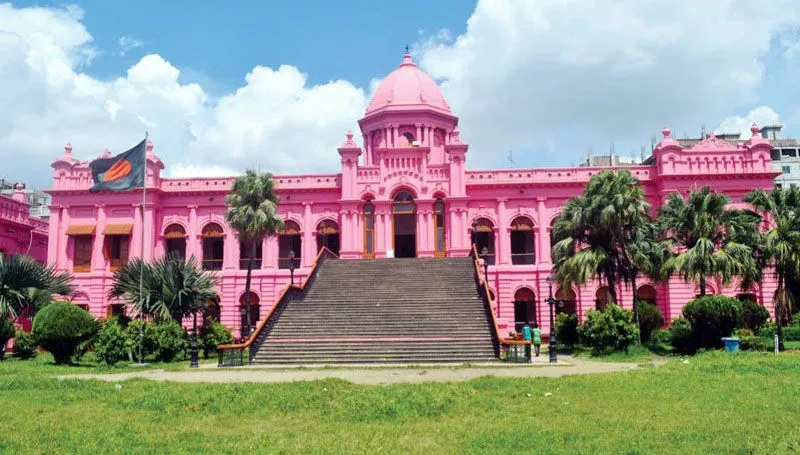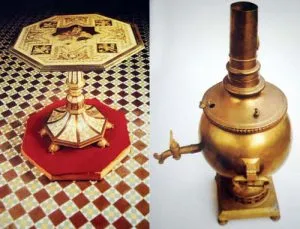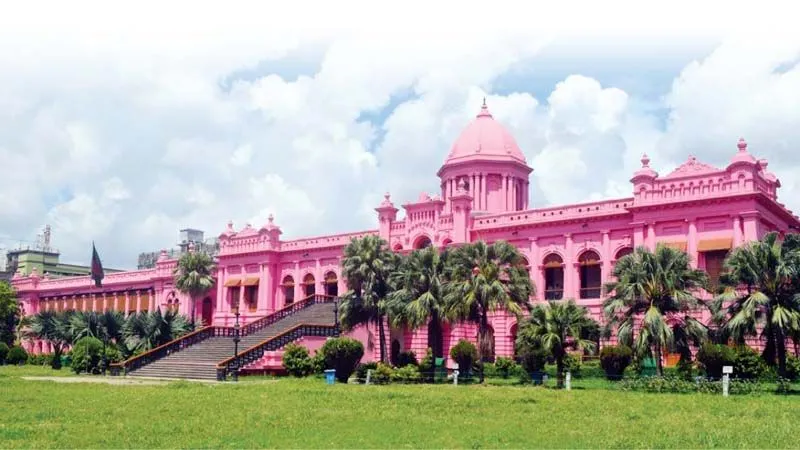
Ahsan Manzil on the banks of Buriganga river of Dhaka. This area was formerly known as Islampur Kumratuli Mahalla. In the middle of the 18th century, Sheikh Inayat Ullah, a zamindar of Jamalpur Pargana (now Faridpur, Barisal), built a promising house named Rangmahal. After the death of Inayat Ullah, his son Sheikh Motiullah sold it to the French merchants. The French built their own trading facilities here. In the northwest corner, a circular pond called 'luus jalla' is built. Khwaja Alimullah, the father of Nawab Abdul Ghani, purchased the kuthi from the French in 1835 and started living there from the old house of Begum Bazar by reforming it to fit his home. Later, there are no changes in the old buildings due to its many changes and modifications. In 1832, Nawab Abdul Ghani reorganized the entire palace and named it after his son Khwaja Ahsan Ullah.
'Ahsan Manzil' The entire Ahsan Manzil was severely damaged by breaking down some parts of the inner circle of Tornado on April 7, 1888. The present high dome is added when the damaged Ahsan Manzil is rebuilt. During that period, there was no such a glorious building like Ahsan Manzil. Due to which the palace of the palace was one of the highest peaks in the city, it attracted attention from far away.
Among other buildings built in Dhaka in the nineteenth century, Ahsan Manzil is a remarkable and unique artistic architecture. The beautiful courtyard of the scenic landscape of Buriganga is situated on the south side. The entire Ahsan Manzil is divided into two parts. The dome on the east side is called the Palace Building (Rangamahal) and the building of the western part of the residential complexes is said to be called nana or indoor mahal. The palace building is again divided into two balanced areas. The high octagonal dome is raised on the circular cell in the middle. In the east, there is a bedroom salon, playing card room, library and three guest rooms and a nostrum, Hindu house room and several residential rooms in the west. Dining hall on the east side of the lower ground and Blind rooms in the west, Darbar Hall and Toshakhana. The stretch of the palace stretched on the southern side of the palace building and the Nahabatkhana on the road were rebuilt in 1897 after the earthquake collapsed.

The Nawabs of Dhaka, after spending huge amount of money on various welfare activities and political activities, are lenders to local zamindars and British governments. In 1907, Nawab Salimullah was forced to hand over the lost zamindari to the Court of Wards. After the death of Nawab Salimullah in 1915, after the death of his son Habibullah, one of the zamindari parganas was being overturned for the sake of loan. The heirs who separated themselves with their own resources. It was impossible to renovate the Rajprasad building in a confrontation and collision among themselves and in due course, the building was abandoned.
In the absence of the authorities, the historic architecture of the nawabs surrounding Ahsan Manzil, and the land of the people, came to the stage of destruction. Under the Land Reclamation Act, in 1952, all Nawab Estate was acquired officially except in Ahsan Manzil and adjacent areas and Nawabs Khas lands. Then, in keeping with the management of Ahsan Manzil, the heirs of the new property of the new Court of Wards are kept under the management of the non-acquisition property. After the death of Nawab Habibullah in 1958, his eldest son, Khwaja Hassan, came in as parting Nawab. Meanwhile, Khwaja family members can go abroad for the sake of survival and employment. In the fifties, when they left the palace, they became more worn because of lack of reform. Without the owner, the renting house is full of illegal occupants, to rent its rooms to many people. Around the floating houses, the elegant, dirty and intolerable environment created in the evergreen palace premises.
In 1985, the Ahsan Manzil Palace building and the adjacent courtyard were acquired under government control and according to the rules of the martial law, it was decided to establish a memorial museum in the proper manner under the control of the National Museum. In 1986, the implementation of the work laid down in the overall responsibility of the National Museum began to be taken in possession of its original structure and to restore the original state to as much as possible. Deputy commissioner of Dhaka Ahsan Manzil has been responsible for the acquisition of the buildings and land and compensation for the proprietors. The responsibility of the reform and beauty of the building is entrusted to the government's Public Works and Architectural Department. National Museum is responsible for the transformation and control of a museum.
It is to be noted that some parts of Ahsan Manzil, including half of the Andoramhal, are still outside the acquisition. During the establishment of the museum, some of the original collections found in the Edward House and Ahsan Manzil's Tosanna Museum of Nawab Court of Wards have been collected through the purchase of the museum authorities.
Furniture was built based on photographs taken in this palace and various rooms in 1904, and exhibition was presented in conjunction with previous original patterns, collecting necessary patterns.
